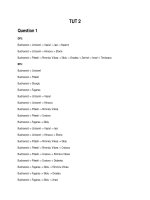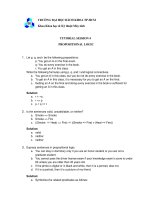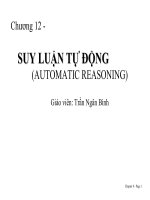Bai giai tri tue nhan tao tut 7
Bạn đang xem bản rút gọn của tài liệu. Xem và tải ngay bản đầy đủ của tài liệu tại đây (151.2 KB, 6 trang )
TRƯỜNG ĐẠI HỌC BÁCH KHOA TP.HCM
Khoa Khoa học & Kỹ thuật Máy tính
1
ARTIFICIAL INTELLIGENCE
Tutorial 7 Questions
UNCERTAINTY and IMPRECISION
Question 1.
1. Prove that:
a. P(A | B ˄ A) = 1
b. P(X ˄ Y | E) = P(X | Y ˄ E).P(Y | E)
c. P(Y | X ˄ E) = P(X | Y ˄ E).P(Y | E)/P(X | E)
(the conditionalized version of Bayes' rule)
Solution:
a. 1
)(
)(
)(
))((
)|(
ABP
ABP
ABP
ABAP
ABAP
b.
)(
)(
)|(
EP
EYXP
EYXP
c.
( ) ( | ). ( | ). ( ) ( | ). ( | )
(| )
( ) (|).() (|)
PY X E PXY EPYEPE PXY EPYE
PY X E
PX E PX E PE PX E
2. Show that the statement
P(A ˄ B | C) = P(A | C).P(B | C)
is equivalent to either of the statements
P(A | B ˄ C) = P(A | C) and P(B | A ˄ C) = P(B | C)
Solution:
)|().|(
)(
)().|(
)(
)(
)|( CBPCBAP
CP
CBPCBAP
CP
CBAP
CBAP
Therefore, if )|().|()|( CBPCAPCBAP then )|()|( CAPCBAP
Similarly, if )|().|()|( CBPCAPCBAP then )|()|( CBPCABP
TRƯỜNG ĐẠI HỌC BÁCH KHOA TP.HCM
Khoa Khoa học & Kỹ thuật Máy tính
2
Question 2.
This exercise investigates the way in which conditional independence relationships affect
the amount of information needed for probabilistic calculations.
a. Suppose we wish to calculate P(H | E1, E2) and we have no conditional independence
information. Which of the following sets of numbers are sufficient for the calculation?
(i) P(E1, E2), P(H), P(E1 | H), P(E2 | H)
(ii) P(E1, E2), P(H), P(E1, E2 | H)
(iii) P(H), P(E1 | H), P(E2 | H)
b. Suppose we know that P(E1 | H, E2) = P(E1| H) for all values of H, El, E2. Now which
of the three sets are sufficient?
Solution:
a. (ii) Bayes rule
b. (i) Because P(E1,E2|H) = P(E1|H).P(E2|H) – conditional independence
Question 3.
Orville, the robot juggler, drops balls quite often when its battery is low. In previous
trials, it has been determined that the probability that it will drop a ball when its battery is
low is 0.9. On the other hand when its battery is not low, the probability that it drops a
ball is only 0.02. The battery was recharged not so long ago, so there is only a 8% chance
that the battery is low. A robot observer with a slightly unreliable robot observation
system sends the information that Orville dropped a ball. The reliability of the robot
observer is described by the following probabilities:
P(observer reports Orville dropped ball | Orville dropped ball) = 0.8
P(observer reports Orville dropped ball | Orville did not drop ball) = 0.1
a. Draw the Bayesian network.
b. Calculate the probability that the battery is low given the information of the robot
observer.
Solution:
a.
BL: battery is low
D: Orville dropped ball
O: observer reports Orville dropped ball
TRƯỜNG ĐẠI HỌC BÁCH KHOA TP.HCM
Khoa Khoa học & Kỹ thuật Máy tính
3
b.
)()(
)()(
)(
)(
)|(
DOPDOP
DOBLPDOBLP
OP
OBLP
OBLP
( ) ( ). ( | ). ( | ) 0.08 0.9 0.8 0.0576P BL O D P BL P D BL P O D
( ) ( ). ( | ). ( | ) 0.08 0.1 0.1 0.0008P BL O D P BL P D BL P O D
)|().()|().()()()( BLDPBLPBLDPBLPBLDPBLDPDP
= 0.08 x 0.9 + 0.92 x 0.02 = 0.0904
( ) ( ). ( | ) 0.0904 0.8 0.07232PO D PD PO D
( ) ( ). ( | ) (1 0.0904) 0.1 0.09096PO D P D PO D
Thus,
0.0576 0.0008
(|)
0.07232 0.09096
PBLO
Question 4.
In your local nuclear power station, there is an alarm that senses when a temperature
gauge exceeds a given threshold. The gauge measures the temperature of the core.
Consider the Boolean variables A (alarm sounds), F
A
(alarm is faulty), and F
G
(gauge is
faulty) and the multivalued nodes G (gauge reading) and T (actual core temperature).
a. Draw a Bayesian network for this domain, given that the gauge is more likely to fail
when the core temperature gets too high.
b. Suppose there are just two possible actual and measured temperatures, normal and
high; the probability that the gauge gives the correct temperature is x when it is working,
but y when it is faulty. Give the conditional probability table associated with G.
c. Suppose the alarm works correctly unless it is faulty, in which case it never sounds.
Give the conditional probability table associated with A.
0.08
0.02
0.8
0.1
TRƯỜNG ĐẠI HỌC BÁCH KHOA TP.HCM
Khoa Khoa học & Kỹ thuật Máy tính
4
d.
Suppose the alarm and gauge are working and the alarm sounds. Calculate an
expression for the probability that the temperature of the core is too high, in terms of the
various conditional probabilities in the network.
Solution:
A suitable network is shown in Figure 1. The key aspects are: the failure nodes are
parents of the sensor nodes, and the temperature node is a parent of both the gauge and
the gauge failure node. It is exactly this kind of correlation that makes it difficult for
humans to understand what is happening in complex systems with unreliable sensors.
Figure 1. A Bayesian network for the nuclear alarm problem
The conditional probability table (CPT) for G is shown below. The wording of the
question is a little tricky because F
G
means “not working” and F
G
means “working”.
c. The CPT for A is as follows:
d. Abbreviating T = High and G = High by T and G respectively, the probability of
interest here is P(T | F
G
˄ F
A
˄ A). Because the alarm's behavior is deterministic, we
can reason that if the alarm is working and sounds, G must be High, we need only
calculate P(T | F
G
˄ G).
)().|()().|(
)().|(
)|(
TPTGFPTPTGFP
TPTGFP
GFTP
GG
G
G
=
)().|().|()().|().|(
)().|().|(
TPTFPTFGPTPTFPTFGP
TPTFPTFGP
GGGG
GG
TRƯỜNG ĐẠI HỌC BÁCH KHOA TP.HCM
Khoa Khoa học & Kỹ thuật Máy tính
5
Letting P(T) = p, P(F
G
| T) = g, and P(F
G
| T) = h, we get
)1)(1)(1()1(
)1(
)|(
phxpgx
pgx
GFTP
G
Question 5.
Given a fuzzy number A as presented in Figure 1. Calculate A/A.
Figure 1. The fuzzy number A
Solution:
520
]5,4[5
]4,2[2/)2(
)(
xorxif
xifx
xifx
xA
A
= [2 + 2, 5 - ]
A
/A
= [(2 + 2
]
2/55/20
]2/5,1[)12/()25(
]1,5/2[)2/()25(
)(/
xorxif
xifxx
xifxx
xAA
TRƯỜNG ĐẠI HỌC BÁCH KHOA TP.HCM
Khoa Khoa học & Kỹ thuật Máy tính
6
End









